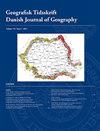失地老年人的社会整合:以马鞍山为例
IF 1.1
4区 社会学
Q4 ENVIRONMENTAL STUDIES
Geografisk Tidsskrift-Danish Journal of Geography
Pub Date : 2021-07-03
DOI:10.1080/00167223.2021.2004902
引用次数: 1
摘要
社会融合对从农村迁移到城市的老年人(失地老年人)的生活质量起着关键作用,而成功的城市融合被认为是构建和谐和老年人友好型社会的关键。很少有研究涉及将主观和客观因素纳入衡量失地老年人的社会融合程度。在这项研究中,我们测量和比较了失地老年人不同社区之间的社会整合水平。我们发现,与商品住房老年人相比,公共住房社区的失地老年人在三个方面的社会融合水平更高:对城市生活的积极态度,对活动的高参与率,以及与邻居一起参与活动。这是因为住在公共房屋的长者有来自相似社会人口群体的邻居,有更多的社会交往。此外,建成环境与两个社区的老年人社会融合水平密切相关,但在两个社区的影响存在一些差异;社会环境的改善可以极大地促进居住在公共住房和商品住房社区的老年人融入社会,特别是改善与邻居的社会联系。本文章由计算机程序翻译,如有差异,请以英文原文为准。
Social integration of land-lost elderly: a case study in Ma’anshan, China
ABSTRACT Social integration plays a key role in the quality of life of the elderly who move from a rural to an urban area (land-lost elderly), and successful urban integration is known to develop harmony and age-friendly society. Very few studies are concerned with incorporating subjective as well as objective elements into measuring social integration levels of land-lost elderly. In this study, we measured and compared social integration levels between different neighbourhoods of land-lost elderly. We found land-lost elderly in the public housing neighbourhoods, and compared to the commodity housing elderly, they have a higher level of social integration in three aspects: having positive attitudes towards urban life, having high participation rate in activities, and participating activities with neighbours. This is because the elderly living in public housing have neighbours from similar socio-demographic groups and have more social interactions. In addition, the built environments are closely related to social integration levels of the elderly in both neighbourhoods, but effects in the two neighbourhoods present a few differences; the improvement in social environments can greatly facilitate social integration of elderly living in public and commodity housing neighbourhoods, especially for improvement in social contacts with neighbours.
求助全文
通过发布文献求助,成功后即可免费获取论文全文。
去求助
来源期刊
CiteScore
5.20
自引率
0.00%
发文量
5
期刊介绍:
DJG is an interdisciplinary, international journal that publishes peer reviewed research articles on all aspects of geography. Coverage includes such topics as human geography, physical geography, human-environment interactions, Earth Observation, and Geographical Information Science. DJG also welcomes articles which address geographical perspectives of e.g. environmental studies, development studies, planning, landscape ecology and sustainability science. In addition to full-length papers, DJG publishes research notes. The journal has two annual issues. Authors from all parts of the world working within geography or related fields are invited to publish their research in the journal.

 求助内容:
求助内容: 应助结果提醒方式:
应助结果提醒方式:


